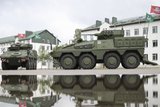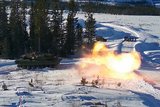Plasan North America nets $300 million JLTV A2 subcontract
AM General will be making tens-of-thousands of JLTVs and Plasan North America will be making subcomponents for the armoured cab. (Photo: US Army)
Plasan North America will manufacture subcomponents for the armoured cabs of AM General Joint Light Tactical Vehicles (JLTVs) under a $300 million deal announced on 17 July.
In February, AM General was awarded an $8.66 billion follow-on contract to produce up to 20,682 JLTVs and up to 9,883 trailers under JLTV A2, with initial deliveries scheduled for Q3 2024, after which trials will begin.
Government testing will be coordinated with Army Test and Evaluation Command, the Marine Corps Operational Test and Evaluation Authority and the Pentagon's Office of the Director, Operational Test and Evaluation. Locations are anticipated to be aligned with Aberdeen Proving Ground, Maryland and Yuma Proving Ground, Arizona.
Related Articles
US Army to receive first AM General JLTVs in Q3 2024
Oshkosh challenges US Army's JLTV contract decision with GAO protest
Plasan officials said the contract award would boost its workforce by 170 over the next 18 months in West Michigan, where they currently have a workforce of 80, and was the result of a 'long-standing relationship with the JLTV program, providing high-quality armour components for the last seven years'.
Related Programmes in Defence Insight
More from Land Warfare
-
![Hungary set to begin using Hero 400 loitering munitions]()
Hungary set to begin using Hero 400 loitering munitions
Developed by Israel's Uvision and with systems being sold in the thousands to multiple European NATO countries and the US, the Hero family of loitering systems is also in production in the US and Italy, the latter through Rheinmetall.
-
![Croatia orders Leopards and CAESAR howitzers as Lithuania orders more CAESARs]()
Croatia orders Leopards and CAESAR howitzers as Lithuania orders more CAESARs
The Leopard is becoming the tank of choice in central and eastern Europe as Croatia joins Lithuania, the Czech Republic and Hungary in ordering the platform. Lithuania and Croatia have also signed for CAESAR howitzers.
-
![Light Reconnaissance Strike – enabling a vital mission set (Studio)]()
Light Reconnaissance Strike – enabling a vital mission set (Studio)
A new system-of-systems concept will unlock digital integration of sensors and weapons for Light Forces, allowing them to shape the battlefield environment on their own terms and upgrade legacy platforms.






















